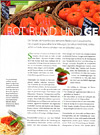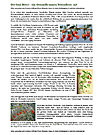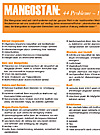NOPAL FEIGENKAKTUS – Aktuelle wissenschaftliche Studien | 26-35
26: World J Gastroenterol. 2006 Jul 21;12(27):4318-24.
Reversing gastric mucosal alterations during ethanol-induced chronic gastritis in rats by oral administration of Opuntia ficus-indica mucilage.
Vázquez-Ramírez R, Olguín-Martínez M, Kubli-Garfias C, Hernández-Muñoz R.
Departamento de Biologia Celular y Fisiologia Instituto de Investigaciones Biomédicas. Universidad Nacional Autónoma de Mexico. Apdo. Postal 70-243. Mexico D.F. 04510, Mexico.
AIM: To study the effect of mucilage obtained from cladodes of Opuntia ficus-indica (Cactaceae) on the healing of ethanol-induced gastritis in rats. METHODS: Chronic gastric mucosa injury was treated with mucilage (5 mg/kg per day) after it was induced by ethanol. Lipid composition, activity of 5'-nucleotidase (a membrane-associated ectoenzyme) and cytosolic activities of lactate and alcohol dehydrogenases in the plasma membrane of gastric mucosa were determined. Histological studies of gastric samples from the experimental groups were included. RESULTS: Ethanol elicited the histological profile of gastritis characterized by loss of the surface epithelium and infiltration of polymorphonuclear leukocytes. Phosphatidylcholine (PC) decreased and cholesterol content increased in plasma membranes of the gastric mucosa. In addition, cytosolic activity increased while the activity of alcohol dehydrogenases decreased. The administration of mucilage promptly corrected these enzymatic changes. In fact, mucilage readily accelerated restoration of the ethanol-induced histological alterations and the disturbances in plasma membranes of gastric mucosa, showing a univocal anti-inflammatory effect. The activity of 5'-nucleotidase correlated with the changes in lipid composition and the fluidity of gastric mucosal plasma membranes. CONCLUSION: The beneficial action of mucilage seems correlated with stabilization of plasma membranes of damaged gastric mucosa. Molecular interactions between mucilage monosaccharides and membrane phospholipids, mainly PC and phosphatidylethanolamine (PE), may be the relevant features responsible for changing activities of membrane-attached proteins during the healing process after chronic gastric mucosal damage.
PMID: 16865772 [PubMed - indexed for MEDLINE]
27: Biol Pharm Bull. 2006 Jul;29(7):1391-6.
Glycoprotein (90 kDa) isolated from Opuntia ficus-indica var. saboten MAKINO lowers plasma lipid level through scavenging of intracellular radicals in Triton WR-1339-induced mice.
Oh PS, Lim KT.
Molecular Biochemistry Laboratory, Institute of Biotechnology, Chonnam National University, Kwangju, South Korea.
The Opuntia ficus-indica var. saboten MAKINO (OFI) has been traditionally used as health food and herbal agent in folk medicine in Korea. In this study, we investigated whether the OFI glycoprotein has antioxidative activity and hypolipidemic effect on Triton WR-1339-induced A/J mice. The OFI glycoprotein inhibits the production of reactive oxygen species (ROS) generated by glucose/glucose oxidase (G/GO) in BNL CL.2 cells. With its antioxidative property, the mice were orally administered in the OFI glycoprotein [50 mg/kg body weight (BW)] for two weeks. Our finding resulted in a significant decrease of plasma lipid levels in Triton WR-1339-treated mice such as total cholesterol (TC), triglyceride (TG), and low-density lipoprotein (LDL). Indeed, mice which induced by Triton WR-1339 were significantly increased the levels of TC, TG and LDL, whereas the high-density lipoprotein (HDL) level obviously decreased. However, the values were reversed at pretreatment with OFI glycoprotein in Triton WR-1339-treated mice. The data also showed that pretreatment with OFI glycoprotein resulted in decrease of thiobarbituric acid-reactive substances (TBARS) level and in increase of nitric oxide (NO) amount in presence of Triton WR-1339-treated mice, while the activities of antioxidant enzyme [superoxide dismutase (SOD), catalase (CAT) and glutathione peroxidase (GPx)] were augmented. Therefore, we speculate that the OFI glycoprotein would be effective in lowering of plasma lipid levels.
Publication Types:
PMID: 16819175 [PubMed - indexed for MEDLINE]
28: Phytother Res. 2006 Sep;20(9):742-7.
Inhibition of nitric oxide synthase expression in activated microglia and peroxynitrite scavenging activity by Opuntia ficus indica var. saboten.
Lee MH, Kim JY, Yoon JH, Lim HJ, Kim TH, Jin C, Kwak WJ, Han CK, Ryu JH.
College of Pharmacy, Sookmyung Women's University, 52 Hyochangwon-Gil, Yongsan-Gu, Seoul, Korea.
Activated microglia by neuronal injury or inflammatory stimulation overproduce nitric oxide (NO) by inducible nitric oxide synthase (iNOS) and reactive oxygen species (ROS) such as superoxide anion, resulting in neurodegenerative diseases. The toxic peroxynitrite (ONOO-), the reaction product of NO and superoxide anion further contributes to oxidative neurotoxicity. A butanol fraction obtained from 50% ethanol extracts of Opuntia ficus indica var. saboten (Cactaceae) stem (SK OFB901) and its hydrolysis product (SK OFB901H) inhibited the production of NO in LPS-activated microglia in a dose dependent manner (IC50 15.9, 4.2 microg/mL, respectively). They also suppressed the expression of protein and mRNA of iNOS in LPS-activated microglial cells at higher than 30 microg/mL as observed by western blot analysis and RT-PCR experiment. They also inhibited the degradation of I-kappaB-alpha in activated microglia. Moreover, they showed strong activity of peroxynitrite scavenging in a cell free bioassay system. These results imply that Opuntia ficus indica may have neuroprotective activity through the inhibition of NO production by activated microglial cells and peroxynitrite scavenging activity. Copyright (c) 2006 John Wiley & Sons, Ltd.
Publication Types:
PMID: 16807879 [PubMed - indexed for MEDLINE]
29: J AOAC Int. 2006 May-Jun;89(3):606-11.
Determination of the appetite suppressant P57 in Hoodia gordonii plant extracts and dietary supplements by liquid chromatography/electrospray ionization mass spectrometry (LC-MSD-TOF) and LC-UV methods.
Avula B, Wang YH, Pawar RS, Shukla YJ, Schaneberg B, Khan IA.
National Center for Natural Products Research, Research Institute of Pharmaceutical Sciences, The University of Mississippi, MS 38677, USA.
Hoodia gordonii is traditionally used in South Africa for its appetite suppressant properties. P57AS3 (P57), an oxypregnane steroidal glycoside, is the only reported active constituent from this plant as an appetite suppressant. Effective quality control of these extracts or products requires rapid methods to determine P57 content. New methods of liquid chromatography/mass spectrometry (LC/MS) and LC-UV for analysis of P57 from H. gordonii have been developed. The quantitative determination of P57 was achieved with a Phenomenex Gemini (Torrance, CA) reversed-phase column using gradient mobile phase of water and acetonitrile, both containing 0.1% acetic acid. The method was validated for linearity, repeatability, and limits of detection and quantification. Good results were obtained in terms of repeatability (relative standard deviation <5.0%) and recovery (98.5-103.5%). The developed methods were applied to the determination of P57 for H. gordonii plant samples, one related genus (Opuntia ficus-indica), and dietary supplements that claim to contain H. gordonii.
Publication Types:
PMID: 16792058 [PubMed - indexed for MEDLINE]
30: Phytochemistry. 2006 Jul;67(13):1390-4. Epub 2006 Jun 9.
Secondary metabolites from Opuntia ficus-indica var. saboten.
Saleem M, Kim HJ, Han CK, Jin C, Lee YS.
Division of Life Sciences, Korea Institute of Science and Technology, P.O. Box 131, Cheongryang, Seoul 130-650, Republic of Korea.
A butanol fraction, from the methanolic extract of Opuntia ficus-indica var. saboten, on purification either by preparative TLC or reversed phase HPLC, yielded three chemical components: isorhamnetin 3-O-(6''-O-E-feruloyl)neohesperidoside (1), (6R)-9,10-dihydroxy-4,7-megastigmadien-3-one-9-O-beta-D-glucopyranoside (2) and (6S)-9,10-dihydroxy-4,7-megastigmadien-3-one-9-O-beta-D-glucopyranoside (3) along with 15 known compounds. Structures of compounds (1-3) were elucidated by aid of spectroscopic analyses. The absolute stereochemistry in compounds 2 and 3 was established with the help of CD data analysis and comparison with the literature data. In a DPPH radical scavenging assay, compound 1 showed moderate inhibitory activity (IC50 = 45.58 microg/ml).
Publication Types:
PMID: 16762382 [PubMed - indexed for MEDLINE]
31: J Agric Food Chem. 2006 Jun 14;54(12):4311-8.
Determination of free amino compounds in betalainic fruits and vegetables by gas chromatography with flame ionization and mass spectrometric detection.
Kugler F, Graneis S, Schreiter PP, Stintzing FC, Carle R.
Institute of Food Technology, Section Plant Foodstuff Technology, Hohenheim University, August-von-Hartmann-Strasse 3, D-70599 Stuttgart, Germany.
Amino acids and amines are the precursors of betalains. Therefore, the profiles of free amino compounds in juices obtained from cactus pears [Opuntia ficus-indica (L.) Mill. cv. Bianca, cv. Gialla, and cv. Rossa], pitaya fruits [Selenicereus megalanthus (K. Schumann ex Vaupel) Moran, Hylocereus polyrhizus (Weber) Britton & Rose, and Hylocereus undatus (Haworth) Britton & Rose], and in extracts from differently colored Swiss chard [Beta vulgaris L. ssp. cicla (L.) Alef. cv. Bright Lights] petioles and red and yellow beets (B. vulgaris L. ssp. vulgaris var. conditiva Alef. cv. Burpee's Golden) were investigated for the first time. Amino compounds were derivatized with propyl chloroformate. While gas chromatography (GC) with mass spectrometry was used for peak assignment, GC flame ionization detection was applied for quantification of individual compounds. Whereas proline was the major free amino compound of cactus pear and pitaya fruit juices, glutamine dominated in Swiss chard stems and beets, respectively. Interestingly, extremely high concentrations of dopamine were detected in Swiss chard stems and beets. Furthermore, the cleavage of betaxanthins caused by derivatization in alkaline reaction solutions is demonstrated for the first time. Amino acids and amines thus released might increase the actual free amino compound contents of the respective sample. To evaluate the contribution of betaxanthin cleavage to total amino acid and amine concentration, isolated betaxanthins were derivatized according to the "EZ:faast" method prior to quantification of the respective amino compounds released. On a molar basis, betaxanthin contribution to overall amino compound contents was always below 6.4%.
Publication Types:
PMID: 16756361 [PubMed - indexed for MEDLINE]
32: Front Biosci. 2006 Sep 1;11:2574-89.
Nutritional and medicinal use of Cactus pear (Opuntia spp.) cladodes and fruits.
Feugang JM, Konarski P, Zou D, Stintzing FC, Zou C.
Department of Obstetrics and Gynecology, University of Arizona, Tucson, Arizona, USA.
Natural products and health foods have recently received a lot of attention both by health professionals and the common population for improving overall well-being, as well as in the prevention of diseases including cancer. In this line, all types of fruits and vegetables have been re-evaluated and recognized as valuable sources of nutraceuticals. The great number of potentially active nutrients and their multifunctional properties make cactus pear (Opuntia spp.) fruits and cladodes perfect candidates for the production of health-promoting food and food supplements. Although traditionally appreciated for its pharmacological properties by the Native Americans, cactus pear is still hardly recognized because of insufficient scientific information. However, recent studies on Opuntia spp. have demonstrated cactus pear fruit and vegetative cladodes to be excellent candidates for the development of healthy food. Therefore, this review summarizes current knowledge on the chemical composition of Opuntia cacti with particular emphasis in its use as food and medicine.
Publication Types:
PMID: 16720335 [PubMed - indexed for MEDLINE]
33: Phytomedicine. 2006 May;13(5):352-8. Epub 2005 Sep 13.
Effect of polysaccharides from Opuntia ficus-indica (L.) cladodes on the healing of dermal wounds in the rat.
Trombetta D, Puglia C, Perri D, Licata A, Pergolizzi S, Lauriano ER, De Pasquale A, Saija A, Bonina FP.
Department of Pharmaceutical Sciences, University of Catania, Italy. dtrombetta@pharma.unime.it
In traditional medicine extracts of polysaccharide-containing plants are widely employed for the treatment of skin and epithelium wounds and of mucous membrane irritation. The extracts of Opuntia ficus-indica cladodes are used in folk medicine for their antiulcer and wound-healing activities. The present study describes the wound-healing potential of two lyophilized polysaccharide extracts obtained from O. ficus-indica (L.) cladodes applied on large full-thickness wounds in the rat. When topically applied for 6 days, polysaccharides with a molecular weight (MW)>10(4)Da from O. ficus-indica cladodes induce a beneficial effect on cutaneous repair in this experimental model; in particular the topical application of O. ficus-indica extracts on skin lesions accelerates the reepithelization and remodelling phases, also by affecting cell-matrix interactions and by modulating laminin deposition. Furthermore, the wound-healing effect is more marked for polysaccharides with a MW ranging 10(4)-10(6)Da than for those with MW>10(6)Da, leading us to suppose that the fine structure of these polysaccharides and thus their particular hygroscopic, rheologic and viscoelastic properties may be essential for the wound-healing promoter activity observed.
Publication Types:
PMID: 16635743 [PubMed - indexed for MEDLINE]
34: Commun Agric Appl Biol Sci. 2005;70(4):733-6.
Postharvest heat and cold treatment to control Ceratitis capitata on cactus pear fruit.
D'Hallewin G, Venditti T, Molinu MG, Dore A, Serusi A.
ISPA-CNR Sezione di Sassari, Via Dei Mille 48, 1-07100 Sassari, Italy. Guy.dhallewin@ispa.cnr.it
In order to work out a quarantine treatment for cactus pear fruit a factorial experimental plan was carried combining postharvest water dips at 20, 50, 54, 58 and 60 degrees C and storage at 1 degrees C for 3, 6 and 10 days. Cactus pear fruit cv 'Rossa' were artificially infested with Med. fly eggs (at least 20 eggs per fruit) then left in the lab at 25 degrees C for 4 days. Treatments took place by dipping the fruit at each water temperature for 2 mm. At each established time fruit was picked and checked for vital larvae and degree of chilling injury (CI). Probit 9 requirements were achieved in all cases when fruit was cold-stored for 10 days. When fruit was kept for 6 days the quarantine requirement was achieved only by dipping the fruit at 58 and 60 degrees C while none dip treatment was effective if fruit was stored for 3 days at 1 degrees C. All Fruit stored for 10 days at 1 degrees C showed severe CI symptoms and when kept for 6 days the same degree of CI was found on fruit dipped in water at 20, 58 and 60 degrees C. No CI was observed after 3 days at 1 degrees C. In conclusion only when fruit was dipped at 50-54 degrees C and stored for 10 days at 1 degrees C the probit 9 condition was attained with acceptable CI symptoms.
PMID: 16628910 [PubMed - indexed for MEDLINE]
35: Zhongguo Zhong Yao Za Zhi. 2005 Dec;30(23):1824-6.
[Study on chemical constituents from Opuntia dillenii]
[Article in Chinese]
Qiu YK, Dou DQ, Pei YP, Yoshikawa M, Matsuda H, Chen YJ.
School of Pharmacy, Yaitai University, China. spuqyk@hotmail.com
OBJECTIVE: To study the chemical composition of Opuntia dillenii. METHOD: Many kinds of chromatography methods were used in the isolation procedure, while the structures of isolated compounds were determined on the aids of NMR and MS spectral analysis. RESULT: A new compound, together with five known compounds, was isolated form the 80% ethanolic extract of its stems. CONCLUSION: The new compound was characterized as opuntioside. Four compounds were obtained for the first from the genus Opuntia, and they were daucosterol, p-hydroxybenzoicacid, L-(-)-malic acid, (E)-ferulic acid. Opuntiol was also separated for the first from the plant.
Publication Types:
PMID: 16499018 [PubMed - indexed for MEDLINE]




















